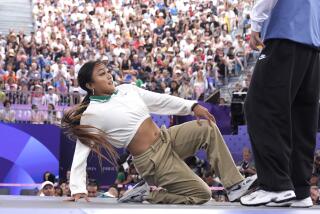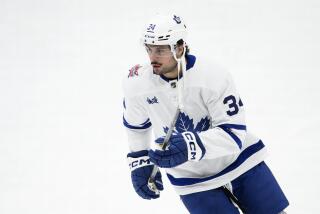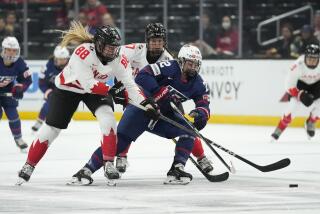Breaking the Ice : Willie O’Ree Broke the NHL’s Color Barrier 39 Years Ago; It’s Rarely Been Crossed Since
- Share via
Willie O’Ree became the NHL’s first black player 39 years ago as a member of the Boston Bruins, but it hardly opened the door for other blacks. O’Ree’s NHL career consisted of 45 games over two seasons, 1957-58 and 1960-61. It was 14 more years before Mike Marson joined the Washington Capitals in 1974 to become the league’s second black player.
“Hockey has been slow in changing, but you have to crawl before you can walk,” said O’Ree, who went on to play more than 20 years professionally with 10 minor league teams--including the Los Angeles Blades and San Diego Gulls.
“You’re finally starting to see that [black] kids do have ability, but they have to get recognition and a chance to do a good job.”
With the arrival of Mike Grier of Edmonton and four other black rookies this season, the NHL is showing small signs that it is becoming more diverse. Very small signs.
According to a 1996 study by Northeastern University’s Sport in Society, 80% of the players in the NBA are black, 67% of the NFL and 17% in major league baseball, but only eight blacks have played at some point this season in the NHL, which has about 725 active players at any one time.
“Hockey is not an option for a lot of blacks,” Bob Ferguson, who coached 14 years at the junior hockey league level and scouted players throughout Minnesota, Michigan, Wisconsin and New England, told the Indianapolis Star. “It is a very, very expensive sport, even for young players, and there is a lack of facilities in the inner cities where many blacks live. To play football, baseball or soccer, all you need is a field. You can find a basketball court in almost any neighborhood, but it is difficult to find an ice rink in a lot of areas.”
A long-standing myth with hockey is that it is a white man’s sport, which may have kept away black players with potential 20 or 30 years ago, but less so today.
“That is no longer true because there is a new generation of people playing hockey,” said Bill Davidge, a scout for the Florida Panthers. “The prejudice reports are overblown. If a guy can play, he can play. Hockey has to find a way to get young black kids on the ice.”
Blacks have made some strides in other areas of hockey. John Paris became pro hockey’s first black coach when he took over the then-Atlanta Knights of the International Hockey League in 1994, and Jay Sharrers has been an NHL linesman for the last three seasons.
But compared to the other three major professional sports in the United States, the NHL--which has joined USA Hockey to form a diversity task force--still has a great deal of catching up to do.
“Our overview is to create more opportunity and access for all people to play hockey,” said Arthur Pincus, NHL vice president of public relations. “[A difference] won’t be seen immediately; it may take a long time. It won’t be like what happened with baseball 50 years ago because when baseball [became integrated], it already had a parallel universe established. For us, it is a matter of creating programs to give people access all over from northern Ontario to Southside Chicago.”
Although the professional hockey leagues do not keep track of other ethnic groups as they are starting to do with blacks, other non-whites have reached the NHL. Washington’s Chris Simon, known for his flowing black hair, is a native North American, and Paul Kariya is of Japanese descent.
“We don’t want to limit ourselves,” said Bryant McBride, the NHL’s director of new business development. “Our goal is to get as many kids who want to play hockey a chance.”
*
When O’Ree made his NHL debut in 1958, he had some problems with racism, but nothing unusual for the time.
“I know that I’ve been dubbed the Jackie Robinson of hockey, but I didn’t have to go through nearly as much as he did,” said O’Ree, who for eight seasons had a black linemate, Stan “Chook” Maxwell. “[Robinson] played in cities were prejudice was so great and deeper than what I had, and he overcame it to still go on and be a great player.
“When I stepped on the ice, the name calling was nothing new to me because I had dealt with it all my life. I’m proud that I’ve always conducted myself as a professional on and off the ice. If I had to fight on the ice, it was because it was in the best interest of the ballclub.”
The NHL does not keep a record of the number of black players it has had in its 80-year history, but according to O’Ree, racism was an early factor.
“When I first signed to play with the Quebec Aces in 1956, they had had an all-black line just two seasons before with Ozzie and Herbie Carnegie, who were brothers, and Manny McIntyre,” O’Ree said. “Man, they were the three best players on the team. They were good enough to play in the National Hockey League. They could do everything, but the only reason they didn’t make it was because they were black.”
Tony McKegney, who played 13 seasons with seven teams, holds the unofficial record for games played by a black player with 912. He says his rookie season (1978-79) was his roughest in the NHL in dealing with racism.
“After that, I established myself as one of the best left-wingers in the game,” McKegney, who scored 320 goals and had 639 points in his career, told the Ottawa Citizen. “But anyone could face derogatory remarks. The Russians and the Czechs were commies. . . .”
So what is it like today?
“When I was younger, I had to deal with [racism] more, and in college there was a little bit at first,” said Grier, one of Edmonton’s most popular players. “But I was taught to not let people bother me by what they say. I love the game too much. My mom used to say the best way to get back at them was to score a goal.”
*
This season, Grier is one of five black rookies, along with Calgary’s Jarome Iginla, Washington’s Anson Carter, Buffalo’s Rumun Ndur and St. Louis’ Jamal Mayers. They make up the largest first-year group of black players ever in the NHL. Grier and Iginla are the only two of that group who have not spent time in the minors this season.
“It makes you feel pretty proud to know you are accomplishing something [that will impact younger players],” Grier said. “Hopefully, the longer I play, race will slowly stop becoming such an issue.”
One of Grier’s heroes growing up was St. Louis goalie Grant Fuhr, who along with Phoenix’s Jason Doig and Vancouver’s Donald Brashear are the only other black players in the league.
Fuhr has been one of the best goalies in the league since 1981, with five All-Star game appearances and more than 300 victories. In 1988, he became the first player of African descent to win a major NHL award when he was selected for the Vezina Trophy as the league’s top goaltender.
But because he wore a goalie mask, many people did not know he was black.
“I really didn’t know of any black players until I was in my teens,” Grier said. “But the first players I heard of were Tony McKegney and Grant Fuhr.”
Grier’s lack of knowledge about the history of black players in the league is not unusual. Most of the players who have made it to the NHL since O’Ree’s debut did not get to play long.
But with addition of players like Grier and Iginla, a leading candidate for rookie of the year, the NHL may not look so white in the future.
“This is just the beginning because the face of the NHL is going to be a lot different in years to come,” McBride said. “In 1969, the NHL was made up of 99% Canadian players. Now, it’s the most diverse [professional league] in the world with players from 17 different countries. Having more black players is something we think is going to happen more and more.”
But will the focus on new youth programs be enough?
“We figure that if a kid picks up a stick and has it in their hands, they are more likely to get into the sport,” said McBride, who also works with Nike/NHL Street and NHL Breakout, two programs that use in-line skates and ice skates to expose kids to hockey.
“Even if it is not on the ice, kids get a chance to see for themselves what it is like to play like a Wayne Gretzky, Mark Messier or Grant Fuhr. By giving them access to the sport by providing the equipment and facility, we’re helping them clear the two biggest barriers with the sport.”
Most hockey experts interviewed said that it will take the next generation of black players before a real difference is made.
“It’s going to take a black player to become known like a Mario [Lemieux], [Jaromir] Jagr or Gretzky, a real superstar before blacks will really be into the sport,” O’Ree said.
“There needs to be a player that people can look up to. There could be a player out there right now, but he’s not there yet.”
* TODAY’S ALL-STAR GAME: C8
(BEGIN TEXT OF INFOBOX / INFOGRAPHIC)
Comparing The Sports
Percent of blacks in major league sports.
NHL: Less than 1%
NBA: 80%
NFL: 67%
MLB: 17%
First in Their Field
The first blacks to break the color barrier in major league sports.
1957: (NHL) Willie O’Ree, Boston Bruins
1950-51: (NBA) Chuck Cooper, Boston Celtics. Sweetwater Clifton, New York Knicks
1947: (MLB) Jackie Robinson, Brooklyn Dodgers
1946: (NFL) Kenny Washington and Woody Strode, Los Angeles Rams
Source: NBA encyclopedia, Bob Oates, Northeastern University; Researched by HOUSTON MITCHELL / Los Angeles Times
More to Read
Go beyond the scoreboard
Get the latest on L.A.'s teams in the daily Sports Report newsletter.
You may occasionally receive promotional content from the Los Angeles Times.






